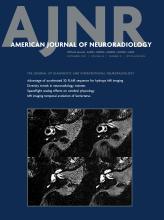Article Figures & Data
Tables
- Table 1:
Baseline and treatment characteristics of patients with-versus-without near-complete reperfusion (eTICI 2c–3)
Variable Near-Complete Reperfusion (n = 186) No Near-Complete Reperfusion (n = 224) P Value Age (median) (IQR) (yr) 71.1 (61.2–80.1), n = 186 69.3 (58.4–79.6), n = 224 .12 Baseline NIHSS (median) (IQR) 18 (12–21), n = 186 17 (13–20), n = 224 .29 History of diabetes (No.) (%) 31/186 (16.7%) 46/224 (20.5%) .55 History of past stroke/TIA (No.) (%) 24/186 (12.9%) 33/224 (14.7%) .67 History of prior cardiac disease (No.) (%) 49/186 (26.3%) 47/224 (21.0%) .24 Baseline ASPECTS (median) (IQR) 8 (7–9), n = 186 8 (6–8), n = 224 .13 Collateral score (No.) (%) .06 Poor 2/186 (1.1%) 11/218 (5.1%) Moderate 154/186 (82.8%) 178/218 (81.7%) Good 30/186 (16.1%) 29/218 (13.3%) Study drug to reperfusion time (median) (IQR) (min) 22 (9–39), n = 182 26 (12–52), n = 170 .17 Terminal ICA occlusion (No.) (%) 28/186 (15.1%) 44/223 (19.7%) .24 IV alteplase (No.) (%) 110/186 (59.1%) 122/224 (54.5%) .37 IV nerinetide (No.) (%) 89/186 (47.9%) 107/224 (47.8%) 1.00 Stent retriever as first-line device (No.) (%) 150/204 (73.5) 142/176 (80.7) .103 Carotid stent placement during EVT 22/110 (20.0) 12/81 (14.8) .445 Note:—IQR indicates interquartile range.
CTP Parameter (Median) (IQR) Near-Complete Reperfusion (n = 186) No Near-Complete Reperfusion (n = 224) P Value CBF <20% 0 (0–0) 0 (0–7.5) <.01 CBF <30% 7.6 (0–28.1) 12.0 (0–32.1) .06 CBF <34% 14.3 (2.7–39.4) 19.1 (5.2–47.2) .10 CBF <38% 21.3 (7.1–54.8) 26.4 (9.9–60.9) .20 CBV <34% 5.1 (0–28.1) 9.8 (0–33.3) .07 CBV <38% 6.7 (0–35.6) 13.3 (0–39.0) .048 CBV <42% 10.1 (0–41.2) 17.9 (4.6–46.0) .06 Note:—IQR indicates interquartile range.
↵a Data in columns 2 and 3 are medians and interquartile ranges.
- Table 3:
CTP lesion volumes in patients with near-complete reperfusion who did and did not achieve good outcome at 90 daysa
CTP Parameter(Median) (IQR) Near-Complete Reperfusion with No Good Outcome (n = 54) No Near-Complete Reperfusion with Good Outcome (n = 132) P Value CBF <20% 0 (0–6.9) 0 (0–0) .02 CBF <30% 12.2 (4.4–38.6) 6.0 (0–22.2) .01 CBF <34% 20.6 (8.1–53.0) 13.0 (0–33.6) .02 CBF <38% 33.4 (13.4−73.0) 18.4 (6.6–46.4) .0495 CBV <34% 12.2 (2.9–43.2) 0 (0–20.6) <.01 CBV <38% 19.0 (4.9–54.2) 4.7 (0–23.1) <.01 CBV <42% 21.8 (6.4–66.7) 6.5 (0–28.5) <.01 Note:—IQR indicates interquartile range.
↵a When comparing the performance of multivariable logistic regression models in predicting good outcome at 90 days in patients with near-complete recanalization, model performance slightly increased and information loss decreased when CTP lesion volumes were added in addition to baseline variables, though the area under the curve confidence intervals overlapped (Table 4). Data in columns 2 and 3 are medians and interquartile ranges.
- Table 4:
Performance of multivariable logistic regression models without and with CTP lesion volumes in predicting good outcome at 90 days in patients with near-complete recanalization
Model Pseudo-R2 BIC AIC AUC (95% CI) Baseline variables onlya 0.302 203.6 174.5 0.766 (0.718–0.813) Baseline variables + CBF <20% volume 0.336 201.1 168.9 0.782 (0.735–0.829) Baseline variables + CBF <30% volume 0.357 196.4 164.2 0.785 (0.739–0.831) Baseline variables + CBF <34% volume 0.359 196.0 163.8 0.784 (0.738–0.830) Baseline variables + CBF <38% volume 0.359 195.8 163.6 0.781 (0.735–0.828) Baseline variables + CBV <34% volume 0.343 199.5 167.2 0.778 (0.731–0.824) Baseline variables + CBV <38% volume 0.346 198.8 166.5 0.779 (0.732–0.825) Baseline variables + CBV <42% volume 0.349 198.1 165.9 0.779 (0.732–0.825) Note:—AIC indicates Akaike information criterion; BIC, Bayesian information criterion; AUC, area under the curve; Pseudo-R2, pseudo-R squared.
↵a Baseline variables were prespecified and included age (in years), sex, NIHSS, treatment allocation (nerinetide versus placebo), alteplase treatment, baseline ASPECTS, collateral score (poor versus moderate versus good), and time from onset to CT imaging.












